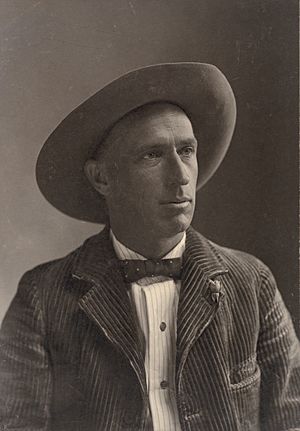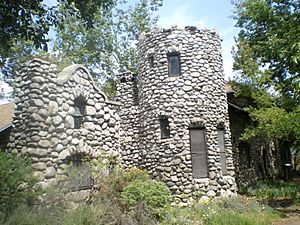Charles Fletcher Lummis facts for kids
Charles Fletcher Lummis (born March 1, 1859, in Lynn, Massachusetts – died November 25, 1928, in Los Angeles, California) was an American journalist and a strong supporter of Native American rights and saving historic places. He traveled a lot in the American Southwest and later settled in Los Angeles, California. There, he became known as a historian, photographer, expert on cultures, archaeologist, poet, and librarian. Lummis also started the famous Southwest Museum of the American Indian.
Contents
Early Life and Adventures
Charles Fletcher Lummis was born in 1859. He lost his mother when he was just two years old. His father, who was a schoolmaster, taught him at home. Lummis went to Harvard University, where he was a classmate of future President Theodore Roosevelt. He left college before finishing his last year.
While at Harvard, he worked as a printer during the summer. He published his first book of poems, called Birch Bark Poems. This special book was printed on thin sheets of birch bark. It became popular and helped him pay for college.
In 1880, at age 21, Lummis married Dorothea Rhodes.
Walking Across America
In 1884, Lummis was working for a newspaper in Cincinnati. He was offered a job at the Los Angeles Times. At that time, Los Angeles was a much smaller city with only about 12,000 people. Lummis decided to walk the 3,507 miles from Cincinnati to Los Angeles!
This amazing journey took him 143 days. All along the way, he sent weekly reports to the newspaper about his trip. He even wrote about meeting the famous outlaw Frank James. The trip started in September and went through the winter. Lummis broke his arm and faced tough winter snows in New Mexico.
During this walk, he fell in love with the American Southwest and its Spanish and Native American people. Years later, he wrote a book about his journey called A Tramp Across the Continent (1892).
Newspaper Editor in Los Angeles
When Lummis arrived in Los Angeles, he became the first City Editor for the Los Angeles Times. He wrote about many interesting stories in the growing city. The work was very demanding. Lummis worked hard until he had a mild stroke, which made his left side weak.
Life in New Mexico
In 1888, Lummis moved to San Mateo, New Mexico, to get better from his paralysis. He rode horses and hunted. Here, he started a new career as a writer, focusing on the special things about the Southwest and Native American cultures.
He later moved to the Pueblo Indian village of Isleta, New Mexico.
Helping the Pueblo People
Lummis slowly recovered from his paralysis. He became good friends with the Isleta Pueblo people, a Tiwa tribe, because he was friendly and kind.
While in Isleta, Lummis became involved in arguments with the U.S. government about Native American education. At this time, the government wanted Native American children to give up their traditions. They sent children to boarding schools where they were often forced to change their clothes, hairstyles, and language. Lummis helped convince the government to let 36 children from the Albuquerque Indian School return home to their families.
He also made friends with Father Anton Docher, a missionary, and Adolph Bandelier, another scholar.
Saving Historic Buildings
Lummis became a strong supporter of saving old buildings. He was president of the Landmarks Club of Southern California. This group was made of volunteers and raised money to protect California's Spanish missions. Lummis saw that these historic buildings were falling apart quickly. He wrote in 1895 that if people didn't act, "there will remain of these noble piles nothing but a few indeterminable heaps of adobe." He believed it was important to save these special places.
Magazine Editor and Activist
In 1892, Lummis published Some Strange Corners of Our Country, sharing what he had discovered. From 1893 to 1894, he traveled in Peru to study local people.
After returning to Los Angeles, Lummis became the editor of a regional magazine called Land of Sunshine. The magazine was later renamed Out West in 1901. He published works by famous writers like Jack London and John Muir. During his 11 years as editor, Lummis wrote over 500 articles for the magazine.
Lummis also started a new group for Native American rights called the "Sequoya League." It was named after Sequoyah, a Cherokee leader who created a writing system for his language. Lummis spoke out against the U.S. Bureau of Indian Affairs. He asked his old classmate, President Teddy Roosevelt, to help change how they treated Native Americans.
He helped a small group of Native Americans find a new home after they were forced to leave their land near Palm Springs, California. The Sequoya League also fought against an Indian Agent named Charles Burton. Burton was making Hopi men cut their long hair, which was against their spiritual customs. Lummis helped bring attention to this issue, and the haircutting policy was eventually stopped.
Later Life
In 1905, Lummis became the City Librarian of the Los Angeles Public Library. He resigned in 1911.
That same year, Lummis went blind for a time. He said it was from a sickness he got while exploring ancient Mayan ruins in Guatemala. After more than a year, he got his sight back.
In 1915, Lummis married his third wife, Gertrude.
By 1918, he faced financial difficulties. In 1923, the Southwest Museum gave him a small payment as their founder. In 1925, Lummis also updated and republished his book Some Strange Corners of Our Country, calling it Mesa, Canyon and Pueblo. He also continued his work to protect the rights of the Pueblo Indians.
Death
Charles Lummis passed away on November 25, 1928. His ashes were placed in a wall at his home, El Alisal.
Legacy and Honors
Lummis's influence is still felt today, especially in the Mount Washington area of Los Angeles. His home, The Lummis House, and the museum he started, The Southwest Museum, are close to each other. They are open to the public on weekends for limited hours.
The Lummis House (El Alisal)
Around 1895, Lummis bought a piece of land and spent 13 years building his stone home, which he called El Alisal. It was a large house with an exhibition hall. Lummis often hosted parties there for writers, artists, and other important people. These parties often included Spanish dinners, dancing, and music.
The Lummis House was given to the Southwest Museum in 1910. Today, it is open to the public as a museum and park on Saturdays and Sundays. It is also a main spot for the Lummis Day Festival.
Southwest Museum
By 1907, Lummis had founded the Southwest Museum of the American Indian in Los Angeles. He led the effort to raise money for a new building, which opened in August 1914.
The Southwest Museum was an independent museum until 2003. Then, it joined with the Autry Museum of the American West. The Autry Museum began a big project to protect the huge collection of items Lummis and others had gathered. Many items were moved, but The Southwest Museum still has an exhibit on Pueblo pottery that is free and open on Saturdays.
Lummis Day Festival
Since 2006, the annual Lummis Day Festival has been held in Lummis's honor. It takes place on the first Sunday in June at El Alisal and Heritage Square Museum. The festival includes poetry readings, art shows, music, dance, and family activities.
See also
 In Spanish: Charles Fletcher Lummis para niños
In Spanish: Charles Fletcher Lummis para niños



